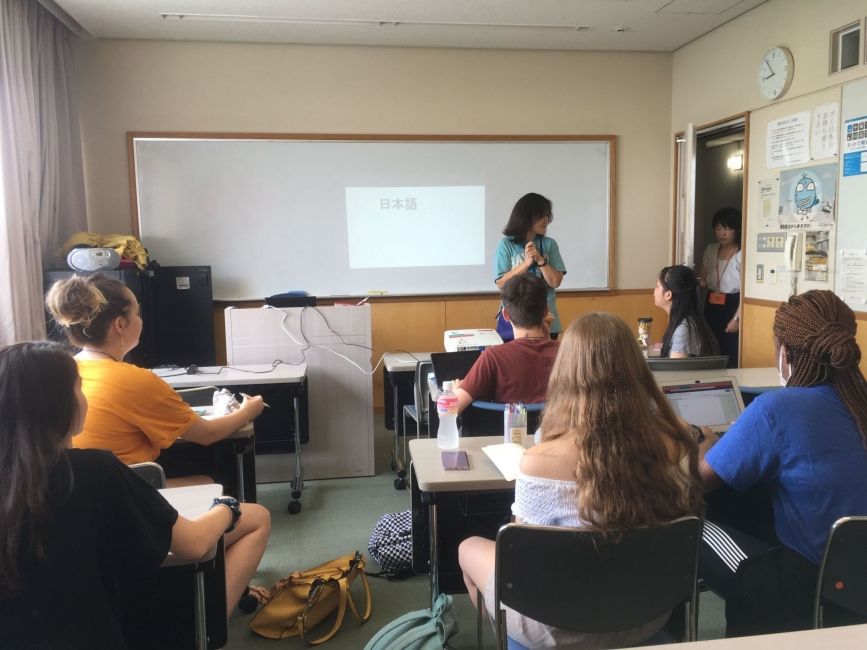A Day in the Life of a Tokyo HSSA Student
Konnichiwa and hello!
How did you start your day today? Was it by eating fish and rice for breakfast? For some of the participants in this Tokyo program, that's exactly what they did! (Others, admittedly, are more inclined to eat the french fries and scrambled eggs!) While they may have found it to be exotic for the first couple of days, it has become a matter of course. This is one of the benefits to not just visiting, but *living in* Japan, as these kids are doing.
In today's blog, I want to give you a quick look at what the kids are doing as part of their day-to-days lives in Tokyo.
A typical day begins with the students waking up in their room. They are in singles, small but equiped with everything thing they need - a bed, a desk, and a closet/shelving unit. The rooms are located in Building A at the National Olympic Youth Center (NOYC). This facility was built to house some of the Olympians during the 1964 Games; as I am walking around campus, I personally like to imagine how awesome it must have been when athletes from various countries, each wearing their nation's colors, were milling about and becoming friends with each other. Even though this is Tokyo, the NOYC is located in an area that offers an escape from the hussle and bussle - and skyscrapers - of the huge city. The campus is wooded and quiet, and is suprememly located with respect to popular areas such as Yoyogi Park, Harajuku, and Shinjuku.
After breakfast, everyone goes to class. There are 4 classes into which students were divided at the beginning of the program. From 8:45-11:55, students learn not only about language but about culture as well. One key component of the language classes is something called "Community Conversations (CC)." These are communicative tasks, such as asking someone how to get to the train station, that they practice in class and then use "for real" with Japanese people during their free time. They have to report each morning on how their CC from the previous day went. Another large part of class is the creation and presenting of projects about, say, one's family. No doubt your child will have much to tell you about classes when they get back!
In the afternoon, after lunch on campus, we most often have excursions that are designed to help us (yes, we Program Leaders are learning right alongside the kids) understand Japanese culture...which, in turn, helps us to better understand the language. Excursions taken thus far include taiko drumming, Japanese paper making, and a visit to a Japanese elementary school. Again, your child will have much to fill you in on; I'm writing in more general terms to give you a broad glimpse of our life here.
Students have varying degrees of free time each day. Sometimes, following an excursion, they have time for dinner and just a bit of sightseeing. Sometimes they have a number of hours to be out, exploring and using their language as well as navigation skills. Given that students always have to be out in groups of three or more, and that they often form groups based on the activity they are wanting to do that day, they have had the chance to get to know a number of new people. A few groups have already hit karaoke a couple of times. Naturally, discovering new restaurants is a popular activity, as is - no surprise here - shopping!
Each evening, participants return to campus by 8:00 for our evening meeting. At those meetings, we give announcements, have show and tell, do ice breakers, and so on. Let me, by the way, take this opportunity to say that YOUR KIDS HAVE BEEN AMAZING! 65 people or so gathering in a rather small area for these meetings could go very badly, but this group has been attentive and respectful, and we Program Leaders appreciate them very much.
After our meeting, it's time for showering/bathing, homework, laundry, and socializing. Here, again, your kids deserve some serious props - they've been doing a fine job completing their assignments. And special recognition goes out to those who have been going to the big public bath each evening! There is *nothing* more relaxing after a long day.
So, there you have it - a brief but, I hope, informative - description of the day-to-day here in Tokyo. In and of itself, it may seem rather mundane. Therein, however, lies the beauty - it is precisely when things have come to feel familiar for the kids that they know they are immersed in an experience that will shape them forever.
Related Posts

Experiencing Life as a Japanese Student
CIEE's Language and Culture in Tokyo program participants got a peek of life as a Japanese student by participating in an afternoon of activities at a local Japanese school. The... keep reading

Why Choose High School Summer Abroad in Japan with CIEE?
Imagine ancient temples tucked amidst glowing city streets, bamboo groves complete with frolicking deer, and arcades jam-packed with teens and games you’ve never seen. You eat sushi every day and... keep reading

A Day Trip to Asakusa: The Historical Center of Tokyo
How Tokyo Interweaves History into Its Metropolis Tokyo is considered by many to be a major center of advancements and technology. However, what goes under the service is Tokyo's vast... keep reading










